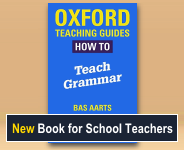Topic: Expressing time
These resources look at the grammatical marking of tense and aspect in the verb phrase, and how this helps express meanings related to time. The resources show how present tense and past tense are used to locate situations in time (He speaks, He spoke), and how the tenses combine with progressive aspect (He is/was speaking) and perfect aspect (He has/had spoken) to express further distinctions of meaning.
Englicious contains many resources for English language in schools, but the vast majority of them require you to register and log in first. For more information, see What is Englicious?

